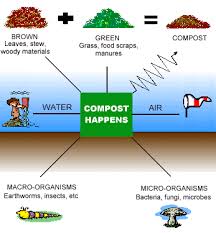How to Compost
1. Start your compost pile on bare earth. This allows worms and other beneficial organisms to aerate the compost and be transported to your garden beds.
2. Lay twigs or straw first, a few inches deep. This aids drainage and helps aerate the pile.
3. Add compost materials in layers, alternating moist and dry. Moist ingredients are food scraps, tea bags, seaweed, etc. Dry materials are straw, leaves, sawdust pellets and wood ashes. If you have wood ashes, sprinkle in thin layers, or they will clump together and be slow to break down.
4. Add manure, green manure ( clover, buckwheat, wheatgrass, grass clippings) or any nitrogen source. This activates the compost pile and speeds the process along.

5. Keep compost moist. Water occasionally, or let rain do the job.
6. Cover with anything you have – wood, plastic sheeting, carpet scraps. Covering helps retain moisture and heat, two essentials for compost. Covering also prevents the compost from being over-watered by rain. The compost should be moist, but not soaked and sodden.
7. Turn. Every few weeks give the pile a quick turn with a pitchfork or shovel. This aerates the pile. Oxygen is required for the process to work, and turning “adds” oxygen. You can skip this step if you have a ready supply of coarse material, like straw.
Once your compost pile is established, add new materials by mixing them in, rather than by adding them in layers. Mixing, or turning, the compost pile is key to aerating the composting materials and speeding the process to completion.

Note: If you want to buy a composter, rather than build your own compost pile, you may consider a buying a rotating compost tumbler which makes it easy to mix the compost regularly.
Carbon/Nitrogen Ratio
All compostable materials are either carbon or nitrogen-based, to varying degrees. The secret to a healthy compost pile is to maintain a working balance between these two elements.
Carbon – carbon-rich matter (like branches, stems, dried leaves, peels, bits of wood, bark dust or sawdust pellets, shredded brown paper bags, corn stalks, coffee filters, conifer needles, egg shells, straw, peat moss, wood ash) gives compost its light, fluffy body.
Nitrogen – nitrogen or protein-rich matter (manures, food scraps, green lawn clippings and green leaves) provides raw materials for making enzymes.
A healthy compost pile should have much more carbon than nitrogen. A simple rule of thumb is to use one-third green and two-thirds brown materials. The bulkiness of the brown materials allows oxygen to penetrate and nourish the organisms that reside there. Too much nitrogen makes for a dense, smelly, slowly decomposing anaerobic mass. Good composting hygiene means covering fresh nitrogen-rich material, which can release odors if exposed to open air, with carbon-rich material, which often exudes a fresh, wonderful smell. If in doubt, add more carbon!
Simplest Composting Methods
~ “No-turn” composting
The biggest chore with composting is turning the pile from time to time. However, with ‘no-turn composting’, your compost can be aerated without turning.
The secret is to thoroughly mix in enough coarse material, like straw, when building the pile. The compost will develop as fast as if it were turned regularly, and studies show that the nitrogen level may be even higher than with turned compost.
With ‘no-turn’ composting, add new materials to the top of the pile, and harvest fresh compost from the bottom of the bin. This can be easily done in an Aerobin Composter, or a WIBO compost bin.
composting leaves ~ Composting leaves
If you have too many leaves to incorporate into the compost bin, you can simply compost the pile of leaves by itself. Locate the pile where drainage is adequate; a shaded area will help keep the pile from drying out.
The leaf pile should be at least 4′ in diameter and 3′ in height. Include a layer of dirt between each foot of leaves. The pile should be damp enough that when a sample taken from the interior is squeezed by hand, a few drops of moisture will appear. The pile should not be packed too tightly.
The pile will compost in 4 – 6 months, with the material being dark and crumbly. Leaf compost is best used as an organic soil amendment and conditioner; it is not normally used as a fertilizer because it is low in nutrients.
~ Leaf-mould tea
You can also use leaves to make a nutrituous “tea” for your plants. Simply wrap a small pile of leaves in burlap and immerse in a garbage can or large bucket of water. Leave for three days, then remove the “tea bag” and dump contents into the compost. Scoop out the enriched water with a smaller bucket and use to water your plants and shrubs.
Enclosed Compost Bins
For small-scale outdoor composting, enclosed bins are the most practical. The least expensive method is to build one yourself from a heavy-duty garbage can. Simply drill 1.5-cm aeration holes in rows at roughly 15-cm intervals around the can. Fill the can with a mixture of high-carbon and high-nitrogen materials. Stir the contents occasionally to avoid anaerobic pockets and to speed up the composting process. If the lid is secure, the bin can be laid on its side and rolled; a length of 2″ cedar ( use a 2×2 or a 2×4) can be bolted to the inside, running top to bottom, to help flip the material. Without this, the contents tend to stay in place while the bin is rolled.
Another option is a compost bin, sometimes called a ‘compost digester’. Compost bins are enclosed on the sides and top, and open on the bottom so they sit directly on the ground. These are common composting units for homes in residential areas where bins tend to be smaller, yet enclosed enough to discourage pests. These bins are inexpensive, but it is difficult to turn the compost, so it can take several months to produce compost. These bins are thin-walled plastic, and may chip along the edges, especially during a freeze.
The most efficient enclosed bin method is the compost tumbler. It’s possible to maintain relatively high temperatures in drum/tumbler systems, both because the container acts as insulation and because the turning keeps the microbes aerated and active. An interior “paddle” aids aeration and prevents clumping of the composting materials. This greatly speeds up the composting process.
An enclosed ‘tumbler’ system offer the following benefits:
– speeds up the composting process
– can compost year-round, due to higher internal temperature
– cannot be accessed by rodents, raccoons, dogs or other critters
– keeps compost neatly enclosed and odor-free, well-suited for residential areas

